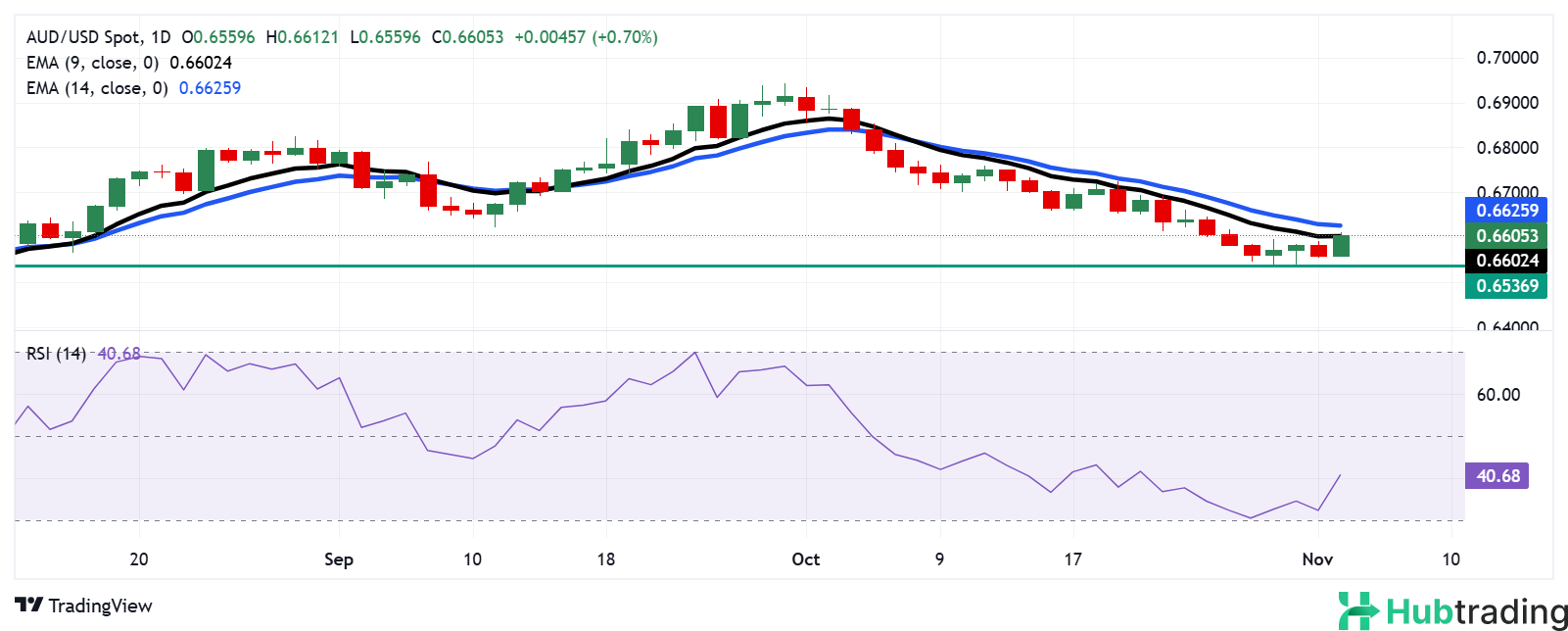- The Australian Dollar strengthened after the TD-MI Inflation Gauge showed a 0.3% month-on-month rise in October, up from the previous 0.1% increase.
- The Reserve Bank of Australia is broadly expected to keep the cash rate steady at 4.35% on Tuesday.
- The US Dollar may gain support from safe-haven demand due to uncertainty around the US presidential election results on November 5.
The Australian Dollar (AUD) gained strength following the Melbourne Institute’s Inflation Gauge release on Monday. The Reserve Bank of Australia (RBA) is anticipated to keep the cash rate at 4.35% at its Tuesday policy meeting, with underlying inflation, indicated by the trimmed mean, remaining high. This expected hawkish stance by the RBA continues to support the AUD, boosting the AUD/USD pair.
The TD-MI Inflation Gauge rose by 0.3% month-over-month in October, up from a 0.1% increase in the prior month, marking the highest level since July and preceding the RBA's November meeting. Annually, the gauge climbed to 3.0%, up from the previous 2.6%.
The US Dollar (USD) weakened after weaker-than-expected US October Nonfarm Payrolls (NFP) data was released on Friday. However, uncertainty surrounding the US presidential election results on November 5 may drive safe-haven flows, potentially supporting the Greenback.
Traders are also focusing on the upcoming Federal Reserve (Fed) policy decision, with a 99.6% probability of a 25 basis point rate cut expected this week, according to the CME FedWatch Tool.
Daily Digest Market Movers: Australian Dollar rises after key domestic data
- ANZ Australia Job Advertisements grew by 0.3% month-over-month in October, a slowdown from the revised 2.3% gain in September. Despite the slower pace, this marks a second consecutive monthly increase.
- On Sunday, China’s Commerce Minister Wang Wentao met with Australia’s Trade Minister Don Farrell, with China expressing its hope for improved business conditions and fair treatment for Chinese companies in Australia.
- The final New York Times/Siena College poll shows Vice President Kamala Harris leading slightly in Nevada, North Carolina, and Wisconsin, while former President Donald Trump has a narrow lead in Arizona. Candidates remain in tight races across several battleground states, with all results within a 3.5% margin of error.
- The US Bureau of Labor Statistics reported a modest 12,000 increase in October’s Nonfarm Payrolls, well below market expectations of 113,000, while the Unemployment Rate held steady at 4.1%.
- Australia’s Producer Price Index rose 0.9% quarter-on-quarter in Q3, exceeding the forecast of a 0.7% increase, though annual growth slowed to 3.9%, down from 4.8%.
- China’s Caixin Manufacturing PMI rose to 50.3 in October, exceeding forecasts and indicating growth in a key sector for Australian trade.
- The US Personal Consumption Expenditures (PCE) Price Index showed core inflation rising by 2.7% year-over-year in September. Initial Jobless Claims hit a five-month low at 216,000, suggesting a resilient labor market.
Technical Analysis: Australian Dollar tests 0.6600 and the nine-day EMA
AUD/USD hovers near 0.6600 on Monday. The daily chart indicates a potential easing of bearish momentum as the pair tests the nine-day Exponential Moving Average (EMA). The 14-day Relative Strength Index (RSI), however, remains below the 50 mark; a rise above 50 could signify a momentum shift from bearish to bullish.
Resistance levels for AUD/USD include the nine-day EMA at 0.6602, followed by the 14-day EMA at 0.6625. Breaking above these could target the psychological level of 0.6700.
On the downside, immediate support is seen at the three-month low of 0.6536, with a break below potentially pushing the pair toward 0.6500.
AUD/USD: Daily Chart Analysis






